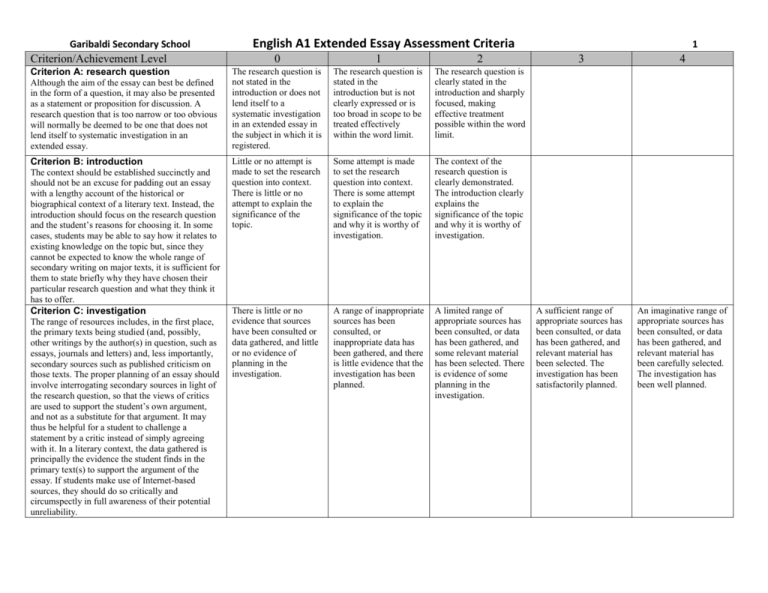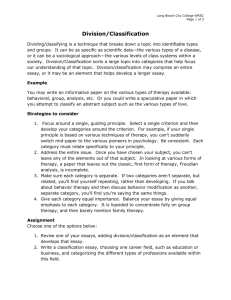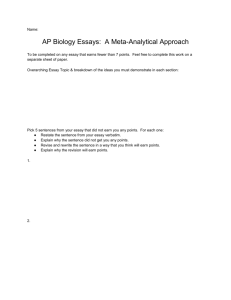SchoolEnglish A1 Extended Essay Assessment Criteria
advertisement

Garibaldi Secondary School Criterion/Achievement Level English A1 Extended Essay Assessment Criteria 0 1 2 Criterion A: research question Although the aim of the essay can best be defined in the form of a question, it may also be presented as a statement or proposition for discussion. A research question that is too narrow or too obvious will normally be deemed to be one that does not lend itself to systematic investigation in an extended essay. The research question is not stated in the introduction or does not lend itself to a systematic investigation in an extended essay in the subject in which it is registered. The research question is stated in the introduction but is not clearly expressed or is too broad in scope to be treated effectively within the word limit. The research question is clearly stated in the introduction and sharply focused, making effective treatment possible within the word limit. Criterion B: introduction The context should be established succinctly and should not be an excuse for padding out an essay with a lengthy account of the historical or biographical context of a literary text. Instead, the introduction should focus on the research question and the student’s reasons for choosing it. In some cases, students may be able to say how it relates to existing knowledge on the topic but, since they cannot be expected to know the whole range of secondary writing on major texts, it is sufficient for them to state briefly why they have chosen their particular research question and what they think it has to offer. Criterion C: investigation The range of resources includes, in the first place, the primary texts being studied (and, possibly, other writings by the author(s) in question, such as essays, journals and letters) and, less importantly, secondary sources such as published criticism on those texts. The proper planning of an essay should involve interrogating secondary sources in light of the research question, so that the views of critics are used to support the student’s own argument, and not as a substitute for that argument. It may thus be helpful for a student to challenge a statement by a critic instead of simply agreeing with it. In a literary context, the data gathered is principally the evidence the student finds in the primary text(s) to support the argument of the essay. If students make use of Internet-based sources, they should do so critically and circumspectly in full awareness of their potential unreliability. Little or no attempt is made to set the research question into context. There is little or no attempt to explain the significance of the topic. Some attempt is made to set the research question into context. There is some attempt to explain the significance of the topic and why it is worthy of investigation. The context of the research question is clearly demonstrated. The introduction clearly explains the significance of the topic and why it is worthy of investigation. There is little or no evidence that sources have been consulted or data gathered, and little or no evidence of planning in the investigation. A range of inappropriate sources has been consulted, or inappropriate data has been gathered, and there is little evidence that the investigation has been planned. A limited range of appropriate sources has been consulted, or data has been gathered, and some relevant material has been selected. There is evidence of some planning in the investigation. 1 3 4 A sufficient range of appropriate sources has been consulted, or data has been gathered, and relevant material has been selected. The investigation has been satisfactorily planned. An imaginative range of appropriate sources has been consulted, or data has been gathered, and relevant material has been carefully selected. The investigation has been well planned. Garibaldi Secondary School Criterion/Achievement Level Criterion D: knowledge and understanding of the topic studied The topic studied here is principally the primary text(s) that is/are the focus of the essay. The quality of the student’s understanding of the primary text(s) is the main concern. The use of secondary sources is not an essential requirement: this may be helpful in the case of classic texts, enabling discussion to start at a higher level, but it should not replace the student’s personal engagement with the primary text(s). Criterion E: reasoned argument Students should be aware of the need to give their essays the backbone of a developing argument. Personal views should not simply be stated but need to be supported by reasoned argument to persuade the reader of their validity. Straightforward description of a literary text through plot summary or narration of the action does not usually advance an argument and should generally be avoided (although, where a littleknown text is under discussion, a brief description may be appropriate). Criterion F: application of analytical and evaluative skills appropriate to the subject Appropriate application of analytical and evaluative skills here is the use of persuasive analysis and argument to support a personal interpretation. Second-hand interpretations that are derived solely from secondary sources will lose marks under this criterion, as will purely descriptive essays that list examples of literary motifs but fail to analyse them. Criterion G: use of language appropriate to the subject There is no single acceptable style for essays, which may be well-written in different ways— with, for example, different degrees of personal emphasis, some writers using the first person and others preferring a more impersonal mode of expression. Clarity and precision of communication in a group 1 essay includes the correct use of language. English A1 Extended Essay Assessment Criteria 2 0 1 2 3 4 The essay demonstrates no real knowledge or understanding of the topic studied. The essay demonstrates some knowledge but little understanding of the topic studied. The essay shows little awareness of an academic context for the investigation. The essay demonstrates an adequate knowledge and some understanding of the topic studied. The essay shows some awareness of an academic context for the investigation. The essay demonstrates a good knowledge and understanding of the topic studied. Where appropriate, the essay successfully outlines an academic context for the investigation. The essay demonstrates a very good knowledge and understanding of the topic studied. Where appropriate, the essay clearly and precisely locates the investigation in an academic context. There is no attempt to develop a reasoned argument in relation to the research question. There is a limited or superficial attempt to present ideas in a logical and coherent manner, and to develop a reasoned argument in relation to the research question. There is some attempt to present ideas in a logical and coherent manner, and to develop a reasoned argument in relation to the research question, but this is only partially successful Ideas are presented in a logical and coherent manner, and a reasoned argument is developed in relation to the research question, but with some weaknesses. Ideas are presented clearly and in a logical and coherent manner. The essay succeeds in developing a reasoned and convincing argument in relation to the research question. The essay shows no application of appropriate analytical and evaluative skills. The essay shows little application of appropriate analytical and evaluative skills. The essay shows some application of appropriate analytical and evaluative skills, which may be only partially effective. The essay shows sound application of appropriate analytical and evaluative skills. The essay shows effective and sophisticated application of appropriate analytical and evaluative skills. The language used is inaccurate and unclear. There is no effective use of terminology appropriate to the subject. The language used sometimes communicates clearly but does not do so consistently. The use of terminology appropriate to the subject is only partly accurate. The language used for the most part communicates clearly. The use of terminology appropriate to the subject is usually accurate. The language used communicates clearly. The use of terminology appropriate to the subject is accurate, although there may be occasional lapses The language used communicates clearly and precisely. Terminology appropriate to the subject is used accurately, with skill and understanding. Garibaldi Secondary School Criterion/Achievement Level English A1 Extended Essay Assessment Criteria 3 0 1 2 3 4 Criterion H: conclusion “Consistent” is the key word here: the conclusion should develop out of the argument and not introduce new or extraneous matter. It should not repeat the material of the introduction; rather, it should present a new synthesis in light of the discussion. Little or no attempt is made to provide a conclusion that is relevant to the research question. A conclusion is attempted that is relevant to the research question but may not be entirely consistent with the evidence presented in the essay. Criterion I: formal presentation This criterion refers to the extent to which the essay conforms to academic standards about the way in which research papers should be presented. The presentation of essays that omit a bibliography or do not give references/citations for quotations is deemed unacceptable (level 0). Essays that omit one of the required elements—title page, table of contents, page numbers—are deemed no better than satisfactory (maximum level 2), while essays that omit two of them are deemed poor at best (maximum level 1). Criterion J: abstract The requirements for the abstract are to state clearly 1) the research question that was investigated, 2) how the investigation was undertaken and 3) the conclusion(s) of the essay. The abstract is judged on the clarity with which it presents the three required elements, not on the quality of the research question itself, nor on the quality of the argument or the conclusions. Criterion K: holistic judgment This criterion allows examiners to reward work that shows initiative, creativity and insight, even if the essay does not achieve the highest standard overall. Routine essays on well-worn topics will not score highly under this criterion. The formal presentation is unacceptable, or the essay exceeds 4,000 words. The formal presentation is poor. An effective conclusion is clearly stated; it is relevant to the research question and consistent with the evidence presented in the essay. It should include unresolved questions where appropriate to the subject concerned. The formal presentation is satisfactory. The formal presentation is good. The formal presentation is excellent. The abstract exceeds 300 words or one or more of the required three elements of an abstract are missing. The abstract contains the elements listed but they are not all clearly stated. The abstract clearly states all the elements listed. The essay shows no evidence of such qualities. The essay shows little evidence of such qualities. The essay shows some evidence of such qualities. The essay shows clear evidence of such qualities. The essay shows considerable evidence of such qualities. Garibaldi Secondary School English A1 Extended Essay Assessment Criteria A 2 B 2 C 4 D 4 E 4 F 4 G 4 H 2 I 4 J 2 K 4 Total 36 4







